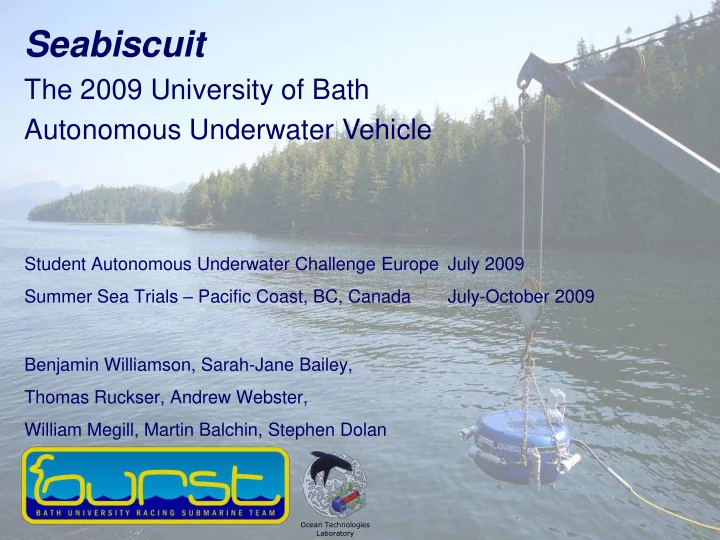

Seabiscuit The 2009 University of Bath Autonomous Underwater Vehicle Student Autonomous Underwater Challenge Europe July 2009 Summer Sea Trials – Pacific Coast, BC, Canada July-October 2009 Benjamin Williamson, Sarah-Jane Bailey, Thomas Ruckser, Andrew Webster, William Megill, Martin Balchin, Stephen Dolan Ocean Technologies Laboratory
Design Evolution
Design Evolution
Mechanical Design Hydrodynamic fibreglass shell Aluminium frame supports dual pressure vessels and peripherals Student designed, student built in-house
Mechanical Design: Pressure Vessels Reliability and ease of access
Seabiscuit
Motor housings Built in-house Materials Blind bore One O-ring Double lip seal Bilge Pressure gradient Oil filled Tapered housing Efficiency
Holonomic Propulsion 6 fixed thrusters 70W Maxon motors Holonomic movement in the horizontal plane Benefits to sensing, mapping and station- holding Holonomic control Benefits of inertial navigation Electrical power 24V SLA battery pack Reversible PWM motor controllers Auto-tuning PID Controller
Design Brief Student Autonomous Underwater Challenge – Europe (SAUC-E) DSTL and Industry sponsored competition Held in Portsmouth, UK Submarine test tank (120m*60m*6m deep) Designed to advance the field of AUVs Foster the development of new ideas and techniques
SAUC-E Competition Competition tasks designed to simulate real life tasks and challenges facing AUVs, including: Searching & identifying objects in the mid- water and on the floor Passing through gates, navigating confined passages Sonar and visual surveys Mapping the environment and object location Tracking moving targets Autonomous docking into 1*1m docking bay
Background Multi-purpose: SAUC-E Competition Canada Field Trials
Background Grey whale conservation
Sensing Vision (dual cameras) Sonar (dual sonars) Mapping Inertial Measurement Unit, Pressure, Compass 6-axis INS to benefit holonomic movement Machine health Battery status (voltage, current, SoC) Motor current consumption Temperature Internal pressure Humidity & leak detection
Buoy Bottom Target Bottom Target Colour Shape Tracking Send Information to AI
Gate Finder
Sonar - Image Processing 360˚ Sonar – Horizontal Plane 120˚ Sonar – Vertical Plane Image analysis through LabVIEW
Sonar - Image Processing Locating a corner
Sonar - Image Processing Locating a corner
Sonar - Image Processing Locating a corner
Sonar - Image Processing Locating a corner
Sonar - Image Processing Locating a corner
Sonar - Image Processing Locating a corner
Sonar - Mapping The same principle applies to wall detection Gathered information can be used for mapping
Sonar - Identifying Objects OBJECT FILTERS - Nearest Neighbour If a particle has ONE close neighbour then the program classifies the two particles as one object. If a particle has TWO close neighbours then the program classifies the particle as noise.
Sonar - Identifying Objects Right: Survey area, the piling dock and shoreline Below: Forward-facing profiling sonar of repeated dock pilings 360 ° Sonar Scan of Dock Pilings
Sonar - Object Tracking Two key parameters are used to track objects from one frame to the next; particle location and area. The framework used for the tracking part of the program is shown below:
Sensor Fusion & Mission Planning Sonar Navigation Sensors • 360 ° Scanning Sonar • DeltaT Profiling Sonar • 6 DoF Inertial Measurement Unit • 3 DoF Magnetometer • Gimballed Compass Vision Environmental sensors • Forward camera • Downward camera • Depth Pinger • Water Pressure Sensor Overall position estimate
Sensor Fusion Combines positional estimates from a variety of sensors , each with different characteristics e.g. update frequency, noise, accuracy, etc. Each sensors positional estimate is assigned a reliability estimate; this determines its weighting (influence) on the overall positional estimate when combining conflicting data. As environmental conditions change, the weightings are adjusted, e.g.: turbid water (murky so lower weighting of vision) turbulent water (increased sonar noise) magnetic disturbances (reduced magnetometer accuracy) Provides an overall position estimate and accuracy estimate
Program Structure Hierarchical Program Overall mission plan runs subtasks Allows for mission variation, either for competition or for difference ocean tasks Artificial Intelligence React to unforeseen circumstances – e.g. object found / not found, allows mission to continue
Flexible program structure - Control as ROV (fly by wire)
Future Design Sensor fusion Navigation in the near-shore environment Station keeping in unsteady flows Mechanical design for deepwater operation
Sponsors & Acknowledgements
To get involved... SAUC-E Competition – July 2010 Canadian Field Trials – July-October 2010 Come and visit the lab 4 East 1.24 Email b.j.williamson@bath.ac.uk
Recommend
More recommend